October 2016 was a very good month for wildlife-watching in this area weather-wise. With high pressure and, unusually, easterly winds dominating for most of the month, we enjoyed lots of calm and sunny, if occasionally a bit chilly weather, with very little rain throughout the month.
Though the days are certainly shortening now, we still had around 10 hours of usable daylight, and the Highland scenery is still ablaze with glorious autumn colours, with most leaves still clinging on, the berry-bearing trees fully laden, and the first dustings of snow on the Cairngorms providing many of my safari clients and myself with some very picturesque landscape photo opportunities.
October is a great month to witness visible migration in action, with large flocks of Geese, Swans and Thrush species often witnessed flying noisily overhead, and this influx of winter visitors from colder areas further north, helped full-day safari bird lists increase up into the 40's, whilst mammal day-lists varied between 4 and 9 depending on the start time and number of venues visited.
 |
| Autumn at Insh Marshes |
Wildlife highlights included:
Local speciality/upland bird species seen regularly during the month included:
Black Grouse,
Red Grouse,
Crested Tit,
Golden Eagle,
White-Tailed Eagle, and
Dipper, we also had a few glimpses of
Crossbill, and a solitary sighting of
Hen Harrier. Whilst a mountain-top adventure also gave us great views of
Ptarmigan...and winter visiting birds were represented by
Whooper Swans, several species of 'grey'
Geese, Redwings and
Fieldfares, a few
Waxwings were seen feasting on berries at the end of the month...and even a couple of
Yellow-Browed Warblers and a
Snow Goose were reported nearby.....
Mammals seen regularly during the month included:
Red Deer (rutting),
Roe Deer,
Reindeer,
Red Squirrel,
Rabbit, and
Mountain Goat, with just a few sightings of
Brown Hare and
Mountain Hare, and just one brief glimpse of a
Stoat. The last week of the month also saw us enjoy great views of
Atlantic Salmon spawning in the upper reaches of local rivers....
And a day on Mull produced
Otter,
Porpoises and
Dolphins.....
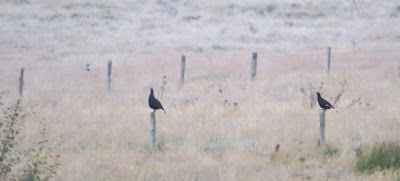 |
| Black Grouse |
The cock
Black Grouse on our traditional moorland 'lek' sites, having largely been missing since early June, began to assemble and occasionally even display at dawn, especially on the colder mornings, with my safari clients and I seeing up to 6 birds at once, although the (still summer length) long grass made viewing quite tricky at times....
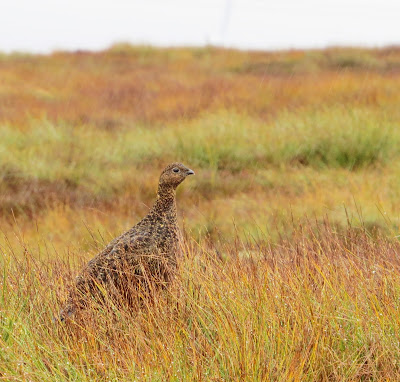 |
| Red Grouse (female) |
Our local
Red Grouse appeared to still be in their (sadly now smaller) family groups, and with the shooting season virtually over, they seem a little less wary and can be a bit easier to see, especially when using my safari vehicle as a slow-moving mobile hide on the quiet tracks through their heather moorland home.
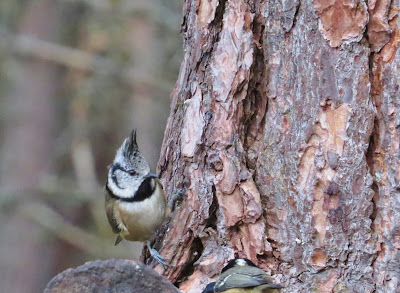 |
| Crested Tit |
Crested Tits, having been generally 'uncooperative' through the summer months, began to become more regular visitors to forest feeding stations, especially soon after dawn, and we were fortunate enough to enjoy some decent and often close views of this true 'local speciality' on a number of occasions....
A bonus by-product of regular winter feeding is sometimes (on colder days) being able to feed the incredibly confiding Coal Tits and (sometimes) Great Tits by hand, an experience much enjoyed by my safari clients...
Crossbills, sadly, but not unusually, were somewhat less obliging however, with our views being almost totally restricted to snatched glimpses of birds flying overhead...identified mainly by their distinctive 'jip- jip' calls....
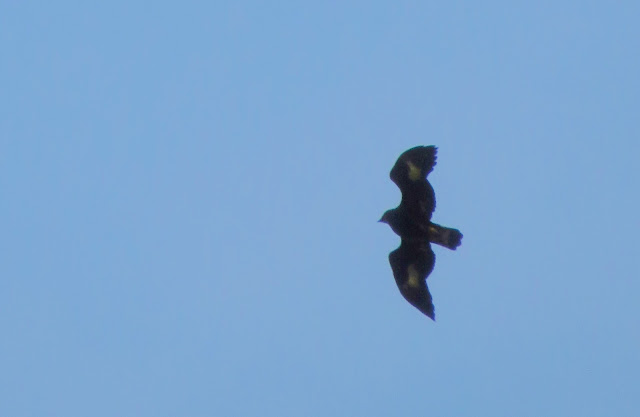 |
| Golden Eagle |
Golden Eagle is truly an iconic bird of the Scottish Highlands, and our regular visits to my favourite upland glen paid off on numerous occasions, with a number of very decent sightings, and a couple of very memorable close-up views of these majestic (and huge!) raptors being obtained.
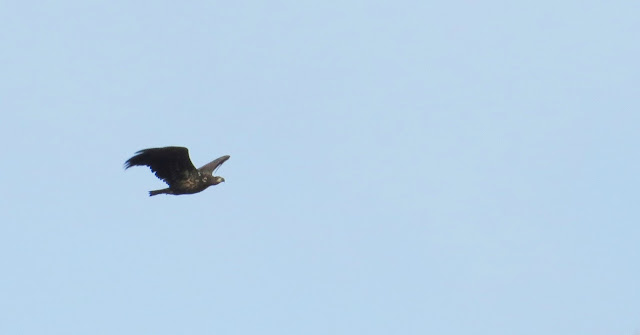 |
| White-Tailed Eagle |
The same glen also gave us a couple of sightings of the even larger
White-Tailed Eagle , with one particularly obliging juvenile bird giving us a splendid close-range fly-past, after a brief aerial battle with a
Hen Harrier! on the 20th of the month, and it being a fairly slow flyer, I even managed to grab a couple of photos...
The shorter days of the winter months actually seem to give us more chance of seeing Eagles, as they have less available hours of daylight hunting time....
The same seems to apply to the other birds of prey too, with
Common Buzzard, Kestrel,
Sparrowhawk,
Peregrine,
Red Kite, and even
Goshawk and
Hen Harrier all being seen on my safaris this month.
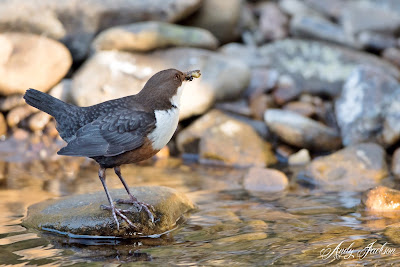 |
| Dipper by safari client Andy Jackson |
Dipper is a bird absent from large areas of Britain, preferring clear, fast-flowing upland rivers over murky, slow-flowing lowland waterways. Fortunately, it is a fairly common sighting in this area, often perching prominently on a rock, and always proves popular with my safari clients ...
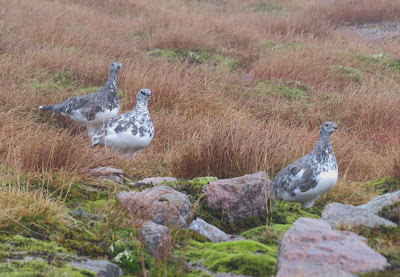 |
| Ptarmigan |
A walk up towards the summit of Cairngorm mountain mid-month, braving sub-zero temperatures , low cloud, and winds gusting to 63mph gave us great, but hard-earned views of over 30
Ptarmigan,
in various states of plumage, with a few almost completely white now...
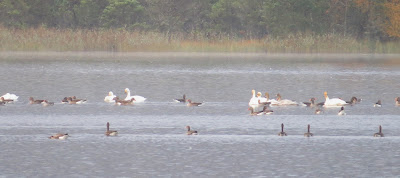 |
| Newly-arrived Greylag Geese and Whooper Swans |
The Moray coast is only about an hours drive north west of Aviemore, and a couple of trips to favourite reserves, bays and harbours gave good views of incoming winter migrants such as
Greylag Geese,
Barnacle Geese,
Pink-Footed Geese,
Brent Geese,
Whooper Swan,
Wigeon,
Teal,
Pintail,
Bar-Tailed Godwit,
Knot, Golden Plover and
Grey Plover.... and scarcer birds such as
Snow Goose,
Scaup and
Green Sandpiper..
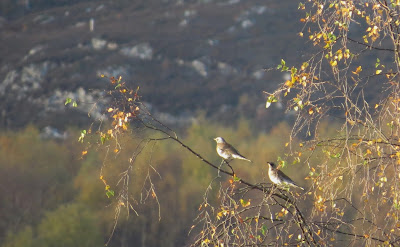 |
| Fieldfares |
Winter thrushes flooded into our area from their summer breeding areas further north and east, first the
Redwings, followed soon after by the
Fieldfares, and they soon set about pillaging our local berry supplies, much to the annoyance of our resident
Blackbirds and
Thrushes!
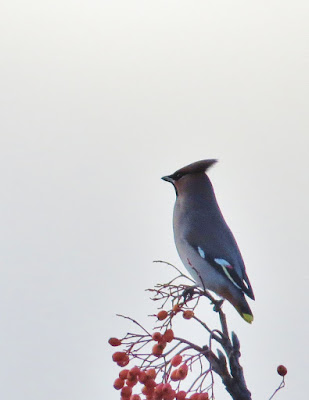 |
| Waxwing |
Waxwings arrived in our area late in the month, with several small flocks of these beautiful 'viking invaders' adding another splash of colour to the already impressive autumnal backdrop as they pillaged the berries from our trees and bushes, their confiding nature often allowing decent photo opportunities ....
Onto mammals now....
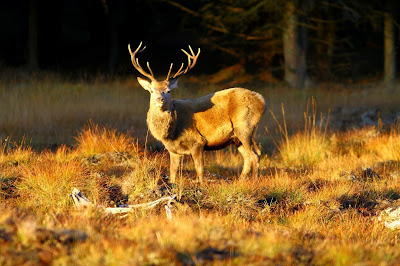 |
| Red Deer stag by safari client Andy Jackson |
'Mammal of the month' for October has to be the
Red Deer, with their spectacular annual 'rut' providing my safari clients with some superb entertainment - the fully antlered stags 'bolving' roars echoing through the glens, as they spend much of the month posturing , fighting off rivals and attempting to mate with as many of their 'harem' as possible - surely one of British nature's 'must-see' experiences?
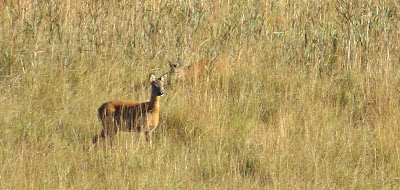 |
| Roe Deer |
Although not as physically impressive as their Red cousins, Roe Deer are probably more often described as cute, but always seem to prove popular with my safari clients, and we were fortunate enough to see them on numerous occasions this month, usually on marshland and woodland fringes, especially soon after dawn....
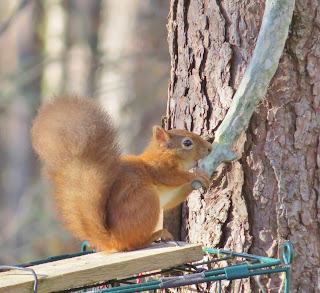 |
| Red Squirrel |
But, when it comes to cuteness..... our local Red Squirrels take some beating, as they again put smiles on many of my safari clients faces, especially those seeing these attractive and characterful little creatures for the first time...
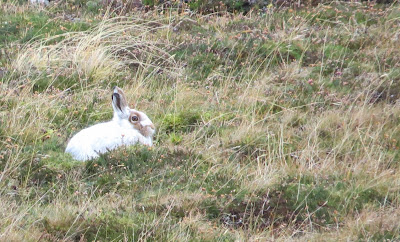 |
| Mountain Hare |
Up in the glens, we had reasonably regular sightings of Mountain Hares (slowly morphing into their white winter coats) and feral Mountain Goats, though sadly, most of the views were at quite a distance, so really good photos eluded me this month.....
 |
| Spawning Atlantic Salmon |
Atlantic Salmon continued to make their way up our local rivers towards their spawning grounds, though the lack of water definitely hampered their progress, until some rain late in the month raised the levels enough to allow them access to some of the upper reaches, where we were then fortunate enough to be able to see them 'leaping' up falls, and also actually watch them spawning in the shallows..
 |
| My trusty Land Rover Discovery ready for action... |
So, to summarise, helped by the decent weather, the annual Red Deer rut, and the miracle of migration, October 2016 turned out to be yet another very enjoyable month for wildlife watching in the Cairngorms National Park, with plenty of excellent sightings, many memorable experiences, lots of happy safari clients, and the odd surprise, all set against beautiful autumnal Highland backdrops.......
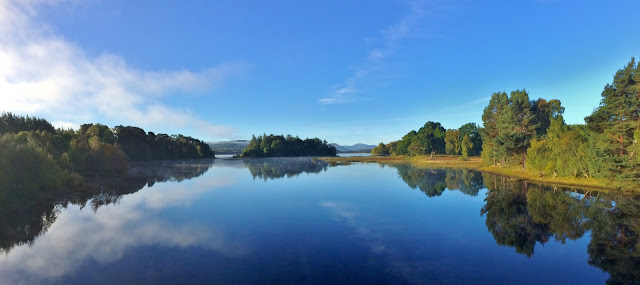 |
| Autumn at Loch Insh |










